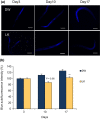Effects of the dipeptides comprising leucine and lysine on lifespan and age-related stress in Caenorhabditis elegans
- PMID: 37324921
- PMCID: PMC10261761
- DOI: 10.1002/fsn3.3256
Effects of the dipeptides comprising leucine and lysine on lifespan and age-related stress in Caenorhabditis elegans
Abstract
The aging process is affected by various stressors. An increase in oxidative stress is related to the impairment of physiological functions and enhancement of glycative stress. Food-derived bioactive peptides have various physiological functions, including antioxidant activities. Dipeptides comprising Leu and Lys (LK and KL, respectively) have been isolated from foods; however, their physiological properties remain unclear. In this study, we investigated the antioxidant/antiglycation activity of dipeptides and their antiaging effects using Caenorhabditis elegans (C. elegans). Both dipeptides showed antioxidant activities against several reactive oxygen species (ROS) in vitro. In particular, the scavenging activity of LK against superoxide radicals was higher than KL did. Moreover, dipeptides suppressed advanced glycation end products (AGEs) formation in the BSA-glucose model. In the lifespan assays using wild-type C. elegans, both LK and KL significantly prolonged the mean lifespan by 20.9% and 11.7%, respectively. In addition, LK decreased intracellular ROS and superoxide radical levels in C. elegans. Blue autofluorescence, an indicator of glycation in C. elegans with age, was also suppressed by LK. These results suggest that dipeptides, notably LK, show an antiaging effect by suppressing oxidative and glycative stress. Our findings suggest that such dipeptides can be used as a novel functional food ingredient. Food-derived dipeptide Leu-Lys (LK) and Lys-Leu (KL) exert antioxidant and antiglycation activity in vitro. Treatment with LK prolonged the mean lifespan and maximum lifespan of C. elegans more than that of KL. Intracellular ROS and blue autofluorescence levels (indicator of aging) were suppressed by LK.
Keywords: Caenorhabditis elegans; antiaging; antiglycation; antioxidant activity; bioactive peptide; dipeptide.
© 2023 The Authors. Food Science & Nutrition published by Wiley Periodicals LLC.
Conflict of interest statement
The authors declare that they have no conflict of interest.
Figures







Similar articles
-
The novel dipeptide Tyr-Ala (TA) significantly enhances the lifespan and healthspan of Caenorhabditis elegans.Food Funct. 2016 Apr;7(4):1975-84. doi: 10.1039/c5fo01302j. Food Funct. 2016. PMID: 26987062
-
Liangyi Gao extends lifespan and exerts an antiaging effect in Caenorhabditis elegans by modulating DAF-16/FOXO.Biogerontology. 2019 Oct;20(5):665-676. doi: 10.1007/s10522-019-09820-7. Epub 2019 Jul 22. Biogerontology. 2019. PMID: 31332584 Free PMC article.
-
An antidiabetic polyherbal phytomedicine confers stress resistance and extends lifespan in Caenorhabditis elegans.Biogerontology. 2017 Feb;18(1):131-147. doi: 10.1007/s10522-016-9668-2. Epub 2016 Nov 16. Biogerontology. 2017. PMID: 27853905
-
Leaf extract of Caesalpinia mimosoides enhances oxidative stress resistance and prolongs lifespan in Caenorhabditis elegans.BMC Complement Altern Med. 2019 Jul 8;19(1):164. doi: 10.1186/s12906-019-2578-5. BMC Complement Altern Med. 2019. PMID: 31286949 Free PMC article.
-
Synthesis of Novel Pinocembrin Amino Acid Derivatives and Their Antiaging Effect on Caenorhabditis elegans via the Modulating DAF-16/FOXO.Drug Des Devel Ther. 2021 Oct 5;15:4177-4193. doi: 10.2147/DDDT.S330223. eCollection 2021. Drug Des Devel Ther. 2021. PMID: 34675482 Free PMC article.
Cited by
-
Identification and Evaluation of Antioxidant and Anti-Aging Peptide Fractions from Enzymatically Hydrolyzed Proteins of Spirulina platensis and Chlorella vulgaris.Mar Drugs. 2025 Apr 8;23(4):162. doi: 10.3390/md23040162. Mar Drugs. 2025. PMID: 40278283 Free PMC article.
References
-
- Abdelkader, H. , Longman, M. , Alany, R. G. , & Pierscionek, B. (2016). On the anticataractogenic effects of L‐carnosine: Is it best described as an antioxidant, metal‐chelating agent or glycation inhibitor? Oxidative Medicine and Cellular Longevity, 2016, 3240261. 10.1155/2016/3240261 - DOI - PMC - PubMed
LinkOut - more resources
Full Text Sources

